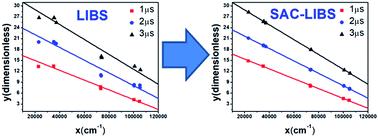CF-LIBS analysis of frozen aqueous solution samples by using a standard internal reference and correcting the self-absorption effect
Abstract
The aim of this paper is to present an innovative procedure to determine the composition of a liquid sample using Laser Induced Breakdown Spectroscopy without calibration curves, or the so-called CF-LIBS (Calibration Free-Laser Induced Breakdown Spectroscopy). Our results of CF-LIBS for the elemental composition were compared with the sample standard concentration determined by Microwave Plasma-Atomic Emission Spectroscopy (MP-AES). In this work, a controlled amount of an internal standard, an extra chemical element, is placed into a liquid sample that is afterward frozen to produce a solid target. The plasma of the target material is produced at atmospheric pressure by focusing a Nd:YAG laser on the frozen target surface. Time-resolved emission spectra are acquired and used for quantitative analysis. An extraordinary increase in the accuracy of elemental concentration is achieved when the spectroscopic data are corrected through an analytical elimination of the self-absorption effect. The corrected data plotted in a Boltzmann diagram show that CF-LIBS can provide good analytical sensitivity and accurate and reliable elemental concentrations when the local thermodynamic equilibrium conditions are experimentally fulfilled and the self-absorption effect on the line intensities is corrected. In the case analyzed here, the concentration results obtained by the improved CF-LIBS procedure give relative deviations of 3.3% maximum when compared with those of MP-AES.



 Please wait while we load your content...
Please wait while we load your content...